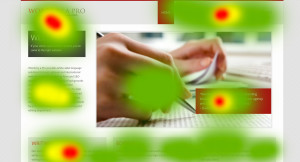Who’s Reading This, Anyway?
I recently came across a series of eye-tracking heat maps that show where people really look when they look at ads. My initial reaction was to think, “Cool!” and then completely forget about it as I do with most Internet things I skim while I’m waiting for my morning coffee to brew. But something about it came back to haunt me as I sat down to do some writing later on in the day.
This idea of “banner blindness,” as mentioned to describe one of the images, is when people ignore banners or ads even when they are placed smack dab in your line of vision. As you can imagine, it’s a relatively new phenomenon, first studied in the 90s when people realized that just putting an ad on your website didn’t cut it anymore — the ad had to be strategically placed and designed as well.
Apparently banner blindness is a well-studied phenomenon and some people even devote their lives to figuring out how to get around it. How can you trick users into viewing your ad?
The whole concept seems like yet another byproduct of the whole “drowning in information, starving for knowledge” Internet era, right up there alongside 24-hour news, celebrity gossip, and those ubiquitous lists of the “[X Number] of [superlative] [noun] — Number [X] Will Blow Your Mind!” Among abominable topics, like “Allegedly Drunk Taylor Swift Allegedly ‘Feeds’ Rum to Alleged Teen Lorde” and “The 5 Most Unusual Things Named after Barack Obama,” it’s easy to understand why we’re starting to tune things out.
Well, now that I’ve lost the majority of my readership to those links, let’s talk about how this is relevant to website writing. As a writer, I often find that I must balance the necessity to write clearly, concisely and intelligently with the biting knowledge that most people won’t read to the end. In a limitless sea of blogs, articles, GIFs and social media sites, getting readers to actually read is quite the conundrum.
More than ever before, people today need to be efficient with their time and energy, especially when it comes to the Internet. And while I’m far from understanding the quirks of website reading, here are a few tips to make your web content more inviting.
- Use bullet points. See what I did there?
- Write in short paragraphs. Anything over five lines is pushing it.
- Get to the point. Your time with your reader is limited.
- Assume that people don’t read your headings and subheadings. Repeat the section topic in the first line.
- Use numbered lists. Yes, they work.
Once you’ve got that down, you’ve at least got text that’s easily scannable, which, let’s face it, is what the majority of readers are going to do with it.
 On the bright side, eye-tracking heat maps did find that occasionally, readers actually read text, and I mean thoroughly, start to finish, every line and every word. Why these readers and not others, you may ask? The answer is simple: Because they truly cared about the topic.
On the bright side, eye-tracking heat maps did find that occasionally, readers actually read text, and I mean thoroughly, start to finish, every line and every word. Why these readers and not others, you may ask? The answer is simple: Because they truly cared about the topic.
So my departing word of advice is to write on topics that people care about. While I will be dismayed if your target audience deeply cares about whether Taylor Swift fed rum to an 18-year-old immortal witch (okay, I read the article), I won’t judge you for writing about it if that’s what hooks your audience. (However, I may judge you for marketing whatever product or service led you to that readership.)
Elizabeth Proctor is a writer and traveler who loves fishing, chess, camels and the X-Files.

